

The future of university debates by Private Eye. Snort. #SafeSpace. Nicholas Christakis - The 2009 TIME 100. Social scientists used to have a straightforward, if tongue-in-cheek, answer to the question of how to become happy: Surround yourself with people who are uglier, poorer and shorter than you are — and who are unhappily married and have annoying kids.
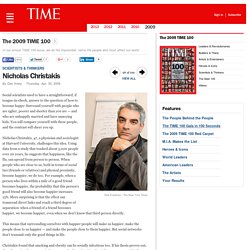
You will compare yourself with these people, and the contrast will cheer you up. Nicholas Christakis, 47, a physician and sociologist at Harvard University, challenges this idea. Using data from a study that tracked about 5,000 people over 20 years, he suggests that happiness, like the flu, can spread from person to person. When people who are close to us, both in terms of social ties (friends or relatives) and physical proximity, become happier, we do too. For example, when a person who lives within a mile of a good friend becomes happier, the probability that this person's good friend will also become happier increases 15%. Christakis found that smoking and obesity can be socially infectious too. Ariely is the James B. Parents Dedicate New College Safe Space In Honor Of Daughter Who Felt Weird In Class Once.
LYNNFIELD, MA—In an effort to provide sanctuary for Lynnfield College students exposed to perspectives different from their own, a new campus safe space was dedicated Wednesday in honor of Alexis Stigmore, a 2009 graduate who felt kind of weird in class one time.

Addressing students at the dedication ceremony, parents Arnold and Cassie Stigmore noted that while the college had adequate facilities to assist victims of discrimination, abuse, and post-traumatic stress, it had until now offered no comparable safe space for students, like their beloved daughter, who encounter an academic viewpoint that gives them an uncomfortable feeling. “When our Alexis felt weird after hearing someone discuss an idea that did not conform to her personally held beliefs, she had no place to turn,” said Arnold Stigmore, standing outside the $2 million space that reportedly features soothing music, neutral-colored walls, oversized floor cushions, fun board games, and a variety of snacks.
Fighting Safe Space Culture & College Censorship: The Best Weapon Is Ridicule « Semi-Partisan Politics. Sometimes the best weapon against the New Age Censors on university campuses is laughter at their desire to be treated like babies All defenders of free speech have a duty to push back against the growing hordes of petty, censorious student activists and their childish demands for trigger warnings, safe spaces and the banning of speakers with contradictory opinions from campus.
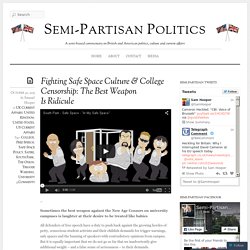
But it is equally important that we do not go so far that we inadvertently give additional weight – and a false sense of seriousness – to their demands. Scholarly articles certainly have their part to play – “In College and Hiding From Scary Ideas” by Judith Shulevitz in the New York Times, for example, was instrumental in bringing the problem of infantilised students to a wider audience. South Park - Safe Space - "In My Safe Space" Leuk om eens de hashtags #safespace #triggerwarning #freespeech te bestuderen. Hier een pleidooi voor meer satire. Trigger Warning: Is the Fear of Being Offensive Killing Free Speech?: Amazon.co.uk: Mick Hume: 9780008125455: Books. Review ‘Superb…This is a first-rate polemic and the most important political book of the year so far’ Rod Liddle ‘This is an important book, and couldn’t be more timely.
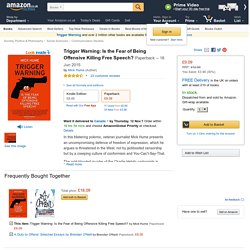
It’s strong-minded, unafraid, determined to knock down all the various specious arguments against free speech, unapologetic about insisting on the value of free expression, and terrifically well argued. In these weak-minded times it’s good to have so uncompromising a defence’ Salman Rushdie ‘What this book does tremendously is pull off the neat trick of summing up just what the hell is going on out there on the great frontiers of speech, offence, liberty and people shouting at each other’ The Times About the Author Mick Hume is a journalist and author. The Halloween Costume Controversy at Yale's Silliman College.
Christakis lives at Yale, where he presides over one of its undergraduate colleges.
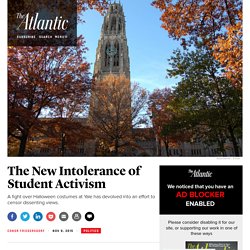
His wife Erika, a lecturer in early childhood education, shares that duty. They reside among students and are responsible for shaping residential life. And before Halloween, some students complained to them that Yale administrators were offering heavy-handed advice on what Halloween costumes to avoid. Erika Christakis reflected on the frustrations of the students, drew on her scholarship and career experience, and composed an email inviting the community to think about the controversy through an intellectual lens that few if any had considered.
Yale Is Imploding Over a Halloween Email. Yale students shouted down professor who allowed offensive Halloween costumes. Dozens of Yale students encircled a professor after he said he would not stop people from wearing offensive Halloween costumes College master said he would not stand in the way of free speech and told offended people to 'look away' or challenge those wearing themVideo shows one young woman's fury at the professor, telling him to 'shut the f*** up' and that he should not sleep at night.
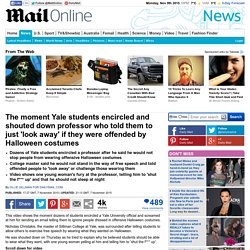
Zou t op NLse universiteiten binnenkort ook zo gaan? #freespeech #SafeSpace #VvMU (uitleg. @GeertenWaling OMG @ "It is not about creating an intellectual space! It is not!". Shit went too far. A confrontation over race at Yale: Hundreds of students demand answers from the school’s first black dean. Hundreds of students surrounded Jonathan Holloway, the first black dean of Yale College (Photo by Isaac Stanley-Becker) Isaac Stanley-Becker, a senior at Yale University who is the former editor of the Yale Daily News, wrote about an unexpected, emotional confrontation at the New Haven, Conn., campus on Nov. 5.

By Isaac Stanley-Becker NEW HAVEN, Conn. — Hundreds of students surrounded the first black dean of Yale College on the university’s quad here Thursday, demanding a public response to recent events that have stoked anguished debates about the treatment of racial minorities on this Ivy League campus. A sophomore standing near the center of the circle of more than 300 students asked the dean, Jonathan Holloway, if he would call on his personal experiences in addressing student demands for additional black faculty, racial sensitivity training for freshmen and the dismissal of administrators viewed as racially inattentive.
Yale students protest over racial insensitivity and free speech. Photo by Christopher Capozziello/Getty Images An email about offensive Halloween costumes has thrown Yale’s campus into tumult, sparking distressed debate around free speech, safe spaces, and the treatment of minority students.

On Thursday, tensions boiled over in the confrontation below, in which a crowd of students encircles the Master of Silliman, one of Yale’s residential houses, and calls for his resignation. (According to the Washington Post, some Yalies are also demanding that the administrator’s wife step down from her position as Associate Master of Silliman.) “It is your job to create a place of comfort and home for the students that live in Silliman … Do you understand that?”
One student shouts at Master Nicholas Christakis, after yelling at him to “be quiet” when he tries to speak. How did this happen? I don’t wish to trivialize genuine concerns about cultural and personal representation, and other challenges to our lived experience in a plural community. A brief history of blackface just in time for Halloween. This 1927 image originally released by Warner Bros., shows Al Jolson in blackface makeup in the movie "The Jazz Singer.
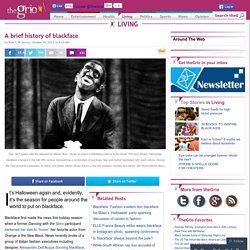
" Historically, blackface emerged in the mid-19th century, representing a combination of put-down, fear and morbid fascination with black culture. Among the most prominent examples: Al Jolson and Eddie Cantor. Today, there’s a fine line between mockery and tribute. (AP Photo/Warner Bros.) It’s Halloween again and, evidently, it’s the season for people around the world to put on blackface.
Blackface first made the news this holiday season when a former Dancing with the Stars participant darkened her skin to “honor” her favorite actor from Orange is the New Black. And let’s not forget the Florida man who blackened up to portray a mortally wounded Trayvon Martin. Blackface minstrelsy first became nationally popular in the late 1820s when white male performers portrayed African-American characters using burnt cork to blacken their skin.
Halloween And Blackface: Same Story, Different Year : Code Switch. Halloween: The day people think it's OK to dress in stereotypical garb.

Adrigu/Flickr hide caption itoggle caption adrigu/Flickr Halloween: The day people think it's OK to dress in stereotypical garb. Yale's big fight over sensitivity and free speech, explained. Yale University has been plunged into campus-wide debate and protest over issues of racial sensitivity and free speech so tense it's turning into a national news story, and it all began with two emails about Halloween costumes. On October 28, a university committee on intercultural affairs sent a campus-wide email urging students to reconsider Halloween costumes that might be racially insensitive. In response a few days later, a lecturer in early childhood development sent an email to the few hundred students in her residential college questioning whether the first email had been necessary and worrying that universities had become "places of censure and prohibition. " Within a week's time, the two emails had led to protests, dramatic confrontations between students and faculty members, and a statement from the university's president that he was "deeply troubled" by students' concerns.
The dispute that started it all might seem trivial. Students demand admin response to racial controversies. Photo Credit: The Yale Daily News This article has been updated to reflect the version that ran in print on Nov. 6. Surrounded by a sea of upturned faces and fighting back tears, Yale College Dean Jonathan Holloway stood on the Women’s Table Thursday afternoon before a crowd of more than 200 students to break the administration’s silence on allegations of racial discrimination that shook campus this week. “It is painful for me — as someone who has a vested interest in supporting you — to hear what you have just told me, but I am glad you did…” he said.
“I’m here for you. I do have your back. Yale Admins' Comments On Offensive Halloween Costumes Spark Protest. Yale University Students Protest Halloween Costume Email (VIDEO 1) Yale University Students Protest Halloween Costume Email (VIDEO 2) Yale University Students Protest Halloween Costume Email (VIDEO 3) Yale University Students Protest Halloween Costume Email (VIDEO 4)
Yale Students Demand Resignations from Faculty Members Over Halloween Email - FIRE. College Students Should Be Scared to Celebrate Halloween - FIRE. By Alex Morey October 30, 2015 If you’re a college student gearing up for Halloween tomorrow, we hope you’re scared. Not of the usual frightful fare—ghosts, haunted houses, terrible people who put their babies in pumpkins—but of the fact that your costume could get you in serious trouble. If this warning sounds freakishly familiar, it is. Over the years, FIRE has amassed a veritable witches’ brew of horror stories in which colleges and universities demand that students refrain from wearing “offensive” costumes. Public institutions violate the First Amendment’s guarantee of free expression when they do so. De universiteit is geen safe space. Ondernemersevent The Road: lef, inzicht en visie. Awww een safe space, wat schattig. Hebben ze er ook psychologische opvang, kleurboeken en zachte dekentjes om het tentamen trauma tegen te gaan?…
Ten strijde tegen de safe space gekte! ‘De universiteit mag geen safe space worden’ Waarom de universiteit wél een safe space moet zijn (1) Waarom de universiteit wél een safe space moet zijn (2) Lecture by political scientist Francis Fukuyama (Lezing) - Radboud Reflects.